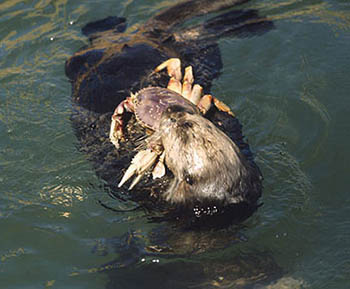A sea otter eats a Dungeness crab. Alaska Department of Fish and Game photo.The internet loves otters. This isn’t news. Did you know they hold ‘hands’ to keep from drifting away from one another while they sleep? Have you seen that video of the one having a snack?
This will be a bitter pill for the internet masses, but fishermen have known the truth for a long time: Otters can be real jerks.
“They are horrible creatures,” said Max Worhatch IV, a Dungeness crab fisherman in Southeast Alaska. “Truly, the most savage beasts on the planet.”
Believe it or not, the hand-holding, snack-grubbing otters are carnivores in the same family as badgers, minks, ferrets, and weasels. Among other things, they eat Dungeness crab. A lot of it.
After being hunted nearly to extinction for their pelts in the 18th and 19th centuries, sea otter populations have rebounded admirably in the Pacific Northwest United States. This outcome is rightfully considered a triumph of marine conservation, but otters are predators and thriving populations present their own challenges to the overall ecosystem — and those whose livelihoods depend on it.
I spoke with Worhatch last week about the history and present-day nuisance of sea otters in Southeast Alaska. The area makes for an interesting case study because otters had been completely wiped out there until the 1960s, when 412 animals were translocated to six Southeast sites in an effort to reestablish colonies.
It worked, and today, they’re thriving. A U.S. Fish and Wildlife report revised in 2014 put the minimum population of sea otters in southeast Alaska at 21,978, with an estimated population of 25,712. The report assumes that the Southeast sea otter population has doubled since 2003, and continues to grow.
This comes as no surprise to Worhatch.
“I was talking to some other crabbers about it this spring,” Worhatch said. “We estimate we’ve lost at least fifty percent of the places where we used to fish. Anecdotally, every place that the otters show up, there’s zero percent Dungeness crab within a few years.”
Otters have a high metabolism and need to eat up to 25 percent of their bodyweight — up to 90 lbs for males and 60 lbs for females — on a daily basis. This adds up to a lot of crab. A 2011 report estimated that in 2015 otters would consume more than 10 million lbs of Southeast Alaska’s dive and crab species.
“What’s happening is that since we’ve lost those other areas, we’re getting jammed into tighter and tighter spots,” Worhatch said. We used to have this big pie, and now half the pie is gone, so the slices are getting smaller and smaller and smaller.”
The crunch on the Dungeness fishery has wide-ranging effects.
“We’re an important shoulder fishery,” Worhatch said. “[The salmon fleet] always traditionally prayed for a good Dungeness season because guys like me wouldn’t show up [for salmon]. Crab was so poor this year. I wouldn’t even be gillnetting salmon right now if it weren’t for crab."
The issue is no secret locally, Worhatch said, the problem is that there’s no easy solution. Sea otters are managed by the U.S. Fish and Wildlife Service and protected under the Marine Mammal Protection Act. Only Native Alaskans from coastal communities are permitted to hunt and kill them, processing options are limited, and there’s no meaningful market for the hides due to rules restricting the sale of otter hides, meat, handicrafts, and clothing outside of native communities.
“A lot of these native villages that used to have a fishing economy have sold all their permits, so now they don’t have any local economy,” Worhatch said. “This could bring a little local economy to these villages, but you can’t really make a living at it.”
Worhatch said he’d like to see native communities advocate to hunt more and work with the government to develop new markets, but progress on this front has been slow.
In the meantime, the otters continue their advance on prime crabbing areas.
“Our crabs have to be six-and-a-half inches across the carapace and male,” Worhatch said. “Otters, of course, are indiscriminate. It’s actually mind boggling how effective they are.”







